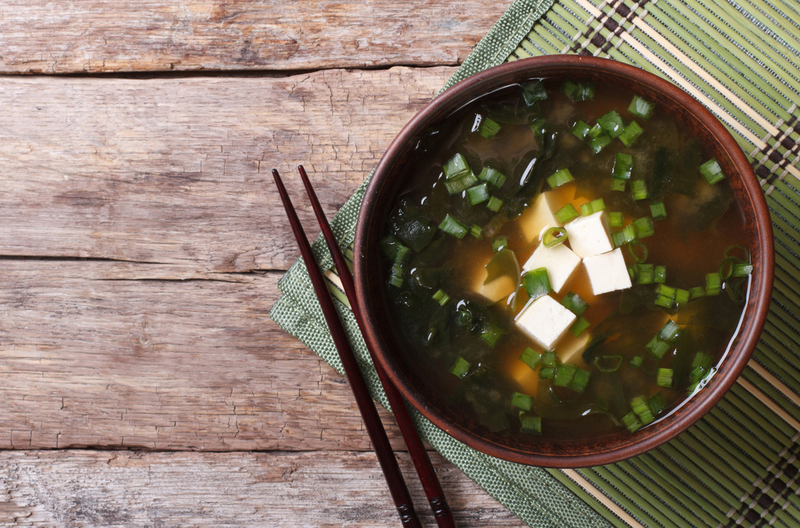If you’re a fan of Japanese food, you might have heard of miso soup before. It’s warm, full of nutritional broth, and perfect as an appetizer before sushi or in a big bowl on its own. But what is miso, and what makes it so healthy?
Miso soup is essentially a two-part soup consisting of “dashi” broth and miso paste. It’s packed with probiotics from the fermented paste, making it great for your gut health. On top of all this, it’s delicious and can be tailored to your liking with veggies or tofu too. (Bonus: you won’t believe how easy it is to make at home!)
Coming up, you’ll learn more about miso paste and the great health benefits of miso soup. If you’re wondering how to make miso soup at home, you’ll also love our easy miso soup recipe and expert tips for buying and making it. Even if you grew up slurping down chicken noodle soup, you might have a new favorite after a taste of this steamy wonder!
What is Miso Paste?
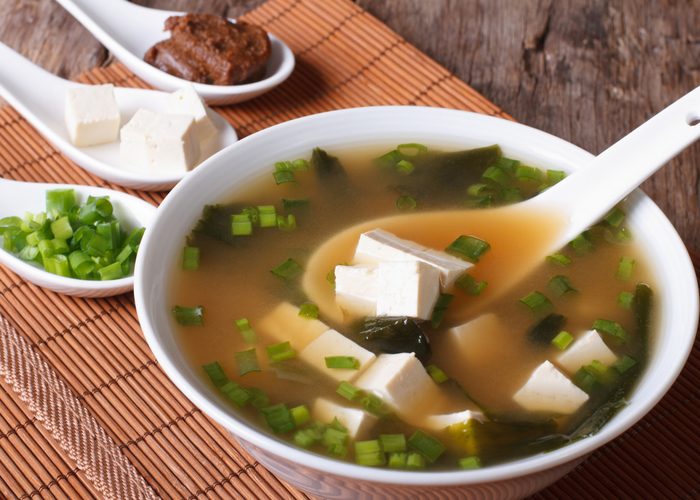
The key ingredient to miso soup is, of course, miso paste! But what is miso? Miso is usually made from fermenting soybeans with salt and a little bit of water. However, the paste can be a combination of soybeans and rice, barley, or wheat too.[1] There’s even soybean-free miso paste nowadays also in case you have a soy allergy. With plenty of variations available, you’re sure to find a flavor that you love. Now, let’s explore the hype around fermentation and why it makes miso such a compelling ingredient.
Fermented foods are great for your digestion and gut health. In short, fermented foods contain probiotics, which are good bacteria known to benefit your immune system and gut health.[2] In the gut, probiotics help keep your intestines healthy with their anti-inflammatory effects.[3] They’re also great for women specifically as they help keep the natural microflora (microorganisms) in the vagina healthy. One study showed that probiotics can even help clear out a bacterial vaginosis infection when taken daily in some women.[4]
So now that we know what miso paste is, and why it makes miso soup such a healing food, let’s learn about the different types of paste.
Types of Miso Paste
Miso paste is versatile and is used in many dishes besides just miso soup. There are some different types to note, as each has a slightly different flavor. Still, they all carry the same umami flavor that our taste buds seem to love. In case you haven’t heard of umami, it is considered one of the five basic tastes that can be described as savory and comforting. Its taste is what makes miso soup not only good for your body, but also your soul.
White Miso Paste
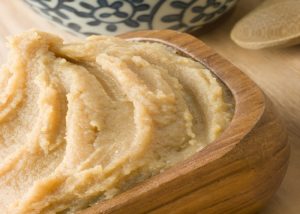
This type of paste is typically made with soybeans and rice, giving it a lighter color than the rest. Additionally, it tends to have a sweeter taste, making it perfect to use in dipping sauces with mayo or in salad dressings. It’s sometimes used for miso soup, depending on how strong you want the flavor to be.
Red Miso Paste
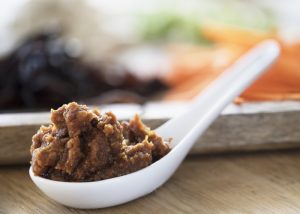
The darker the paste, the stronger the umami flavor. Red miso paste gets its color from having more soybeans and longer fermentation time. Longer fermentation means more probiotics in the product, which are great for your gut health!
Red miso paste can range from dark red to dark brown. It’s perfect in a bowl of heavy miso soup or in a glaze. Just be careful not to add too much paste to your dish the first time you try a new brand, as it can be overwhelming if over-added.
Yellow Miso Paste
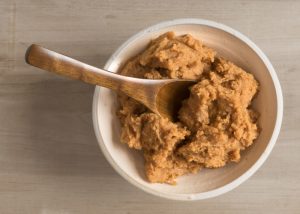
Not too mellow, but not too strong either! Yellow miso paste is a great middle ground that’s usually made from a mixture of soybeans and barley or other grain. It’s ideal for just about any recipe that calls for miso paste. It’s also darker than white miso paste but still pretty light in color. Try it in a soup or as a marinade.
Tip: Always buy the miso paste that needs to be stored in your refrigerator after opening. This is a good sign that there are plenty of live bacteria inside that should be kept fresh.
What Is Miso Soup & How Many Calories Does It Have?

By now you should have a better understanding of what miso paste is, one of the two main ingredients of miso soup. But what else goes in miso soup? Well, dashi broth is the other half of the whole. Dashi stock is different than your average chicken or vegetable stock. It’s made from kelp and dried fish flakes (usually anchovies or sardines). To make it vegan, it can also be made just from mushrooms. This broth is great in various soups and also to boil vegetables or simmer meats.
Besides these key ingredients, this nutritious soup can also contain some silken tofu cubes, seaweed slivers, and soft veggies like carrots and daikon (Japanese radish). It’s really up to you how to make miso soup, but all variations are relatively low calorie. One serving of plain miso soup is only 35 calories, but this number will increase depending on what additional ingredients are added.[5] No joke! It’s a great meal to eat if you tend to snack when you’re bored and are trying to watch your empty carb intake (perfect for you boredom eaters and midnight snackers out there!).
5 Miso Soup Health Benefits You Need to Know
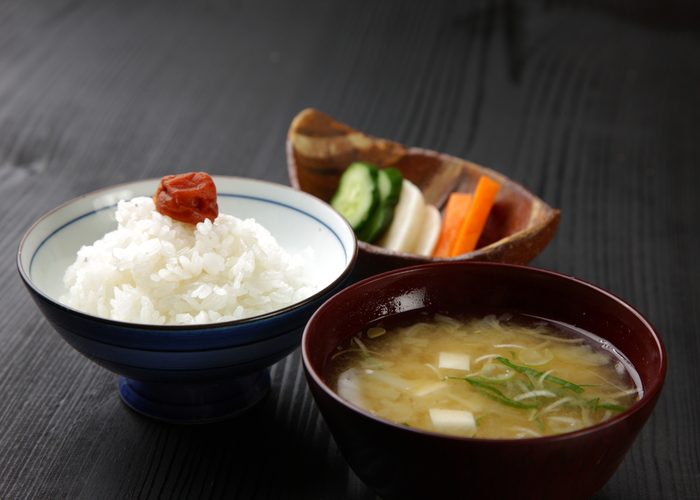
We’ve only just touched the surface on the health benefits of miso soup so far. Here are a few more reasons to try this soup and add it to your regular dinner/snack rotation.
High in Enzymes
Microorganisms, fungi, and yeast all make enzymes as a byproduct during fermentation.[6] So the resulting food at the end of the fermentation process is loaded with these helpful catalysts. Miso paste is no exception and contains enzymes that can be great for your health. Enzymes are important because they speed up chemical reactions in the body, including digestion. The faster you can absorb nutrients and digest food, the faster your metabolism works.
Helps maintain digestion and a healthy gut

As you may know, consuming both prebiotics and probiotics is key to a healthy gut. Our intestines need good bacteria to digest food and fight off any bad bacteria. Prebiotics are essential food for the probiotics. Probiotics are the more talked about superstar that aid in digestion and gut health, among other things. Probiotics are like little warriors in our gut that protect our body and at the same time improve overall function.
Miso is a great food choice because it has plenty of probiotics from the fermentation process. For example, A. oryzae, one of the main probiotics found in miso, has anti-inflammatory properties that can benefit a number of health issues.[7] One study shows that symptoms of inflammatory bowel disease can be decreased through the probiotics in miso.[8]
If you don’t get enough probiotics you could run into trouble. Candida is one kind of yeast overgrowth that can occur if you don’t have enough gut bacteria to keep homeostasis, or even levels, in your body.[9] But don’t worry, there are plenty of probiotic sources out there. Miso soup is a convenient and tasty way to get your dose!
Contains minerals such as magnesium, zinc, and copper
To function properly, our body needs some essential minerals. Magnesium, zinc, and copper are all part of that group.[10] Fortunately, miso soup is a great source of these minerals so you can cross them off your list of supplement pills.
Magnesium helps enzyme reactions to occur, so it’s most functional in combination with fermented foods, as fermented foods contain enzymes like mentioned above.[11] It also helps regulate blood pressure and enables your muscles to contract, which is important during digestion.[12]
Zinc is crucial for you as it helps your blood to clot.[13] Also, you may remember hearing that taking zinc is beneficial if you feel a cold coming on. That’s because zinc strengthens the immune system too.[14]
Copper is important for the body as it helps metabolize the energy (food) you eat.[15] You only need copper in small amounts, so you might not hear about it as an essential mineral that much. Still, it’s important to the overall function of your body.
Fun Fact: Miso is a Japanese word that translates to “fermented beans”. Pretty self-explanatory!
Reduces the risk of cancers

Can you believe that a delicious soup can decrease your chances of getting cancer? It’s true! One study proved that frequent consumption of miso soup (made from soybeans, not an alternative paste) reduces a woman’s risk of breast cancer.[16] The isoflavones found in soy are known to help reduce breast cancer risk, although the method by which this happens is not totally understood yet.[17]
Additionally, another study showed that miso with a longer fermentation time, usually above 180 days, reduced the risk of liver and lung cancer in mice. It also reduced radiation injury in mice too.[18] While further research needs to be done on humans, this test gives an indication of the possible benefits that can be transferred over.
Contains B12 vitamins
Vitamin B12 is important for your blood and nervous system. It’s proven that vitamin B12 can combat symptoms of Alzheimer’s disease.[19] However, vegetarians are at high risk of developing a B12 deficiency.[20] This can be combated with a comforting bowl of miso soup. If the fish broth is a problem for vegetarians, you can substitute for a broth made without fish or a vegetarian dashi broth packet. You’ll still get the B12 benefit with a different broth as it stems from the fermented paste anyway.
Remember: Keep in mind that miso soup is typically very high in
sodium, or salt. Just one teaspoon contains about 300 milligrams of sodium.[21] It’s great in moderation, just don’t eat a whole pot without sharing with your friends and family too.
How to Make Miso Soup: An Easy Miso Soup Recipe
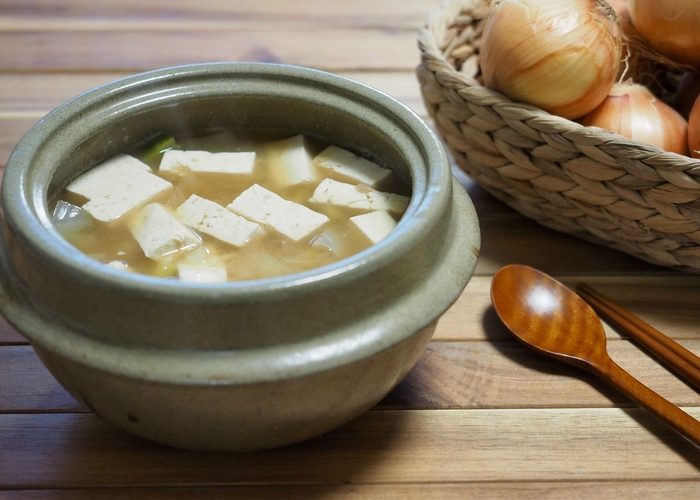
In Japan, it’s common to have miso soup with nearly every meal. Now you can too with this easy miso soup recipe! It takes minimal effort to prepare, with maximum health results. Read on to learn how to make miso soup at home and get your grub on.
Prep Time: 5 mins | Cook Time: 10 mins | Serves: 4 big bowls
Equipment: Pot, small mixing bowl, cutting knife, measuring cup, and whisk
Ingredients
- Miso Paste
- Instant Dashi Broth Packet
- Dried Seaweed
- Silken Tofu
Instructions
- Bring about 5 cups of water to boil in a pot. Turn off the heat.
- Whisk in two teaspoons of instant dashi broth powder.
- In a small mixing bowl, whisk together some warm water and 4 tablespoons of miso paste. This will help the miso paste from clumping in the larger pot.
- Pour miso paste mixture into larger pot.
- Add in chopped tofu and strips of dried seaweed. Let sit for 5 minutes before serving.
Optional: Add in your favorite veggies and spices to jazz up this recipe. If the crowd you’re serving wants different things, lay out some extra goodies for their individual bowls such as green onions, soy sauce, and pickled carrots.
Tips For Buying and Making it
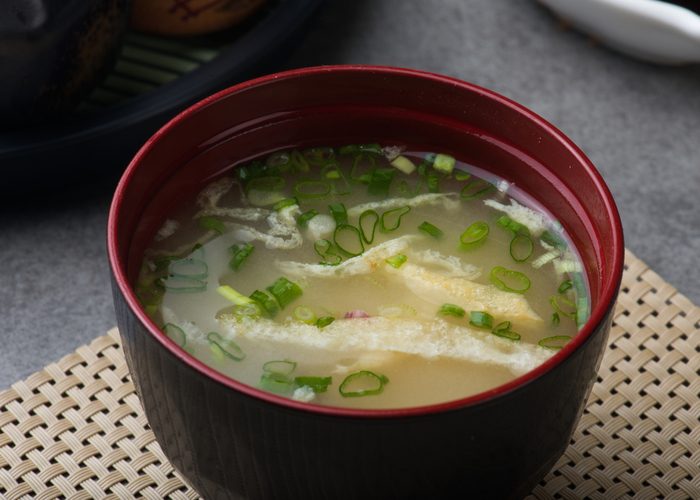
If you’re not familiar cooking with Asian ingredients, buying and making miso soup might seem overwhelming. But, just like any cuisine, if you make it once you’ll be amazed at how easy it is. Plus, there are only two main ingredients to look out for in your supermarket — miso paste and dashi broth. To help you out, consider the following expert tips for buying and making it.
Where to Buy Miso Soup Ingredients
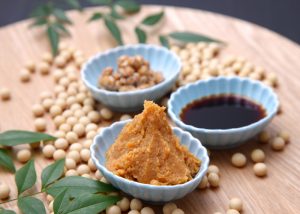
Miso paste is now pretty common in most large supermarkets. Fresh and organic miso is typically found in the refrigerated section of the produce aisle, near the salad dressings. It might be labeled something simple, such as soybean paste.
There is also powdered miso, which can be found near the soy sauce, or in the aisle dedicated to international cuisine. However, the “instant” miso soup packets in some stores may not contain probiotics anymore. Make sure to check the ingredients for “live cultures”. The best way to go is just to buy organic miso paste so you know you’re not missing out on any health benefits.
For the dashi broth, you can also look in the international aisle, but it might be a bit more difficult to find. These days, there are instant dashi broth packets sold in many Asian markets. If you’re feeling extra adventurous, you can try making dashi broth from scratch. For that, you’ll need dried kelp and fish flakes. But don’t stress out if you aren’t able to make miso soup with dashi. You can always substitute for another kind of healthy broth, either homemade or instant.
The other optional, but highly recommended ingredients to add are silken tofu cubes, seaweed, chopped mushrooms, and green onions. The tofu will give the miso soup some extra protein and a great diversity of texture.
Miso Soup Recipe Tips
- You can easily ruin the benefits of miso soup if you boil the broth after you add in the miso paste. When you boil the paste, you are destroying some of the fermented benefits with the high heat. To avoid this, boil the broth in a big pot on the stove and then turn off the heat. Once the bubbles stop, mix in the miso paste and serve the same day.
- If you like spicy foods, add a touch of chili paste to the broth. Alternatively, drizzle some chili-infused oil on top of the
finished product . This will add a nice kick to the soup if you’re sick and wantto get your nose running, or maybe you just like spice. - Don’t worry about the miso paste separation that might happen
if you leave a bowl of soup untouched for too long. Like kombucha,the fermented goodness tends to divide from the watery liquid, making acloudy substance that can look strange to some. This is totally normal. Justgive the soup a quick stir and continue slurping it up.
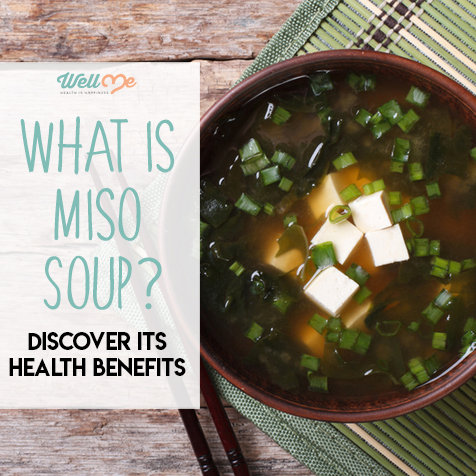
Conclusion
Now that you know about amazing miso paste, and low-calorie, nutrient-dense miso soup, you are prepared to go make your own! It’s easy to make and the health benefits are plentiful. Make your next dinner party Japanese themed with miso soup and DIY sushi — enjoy!
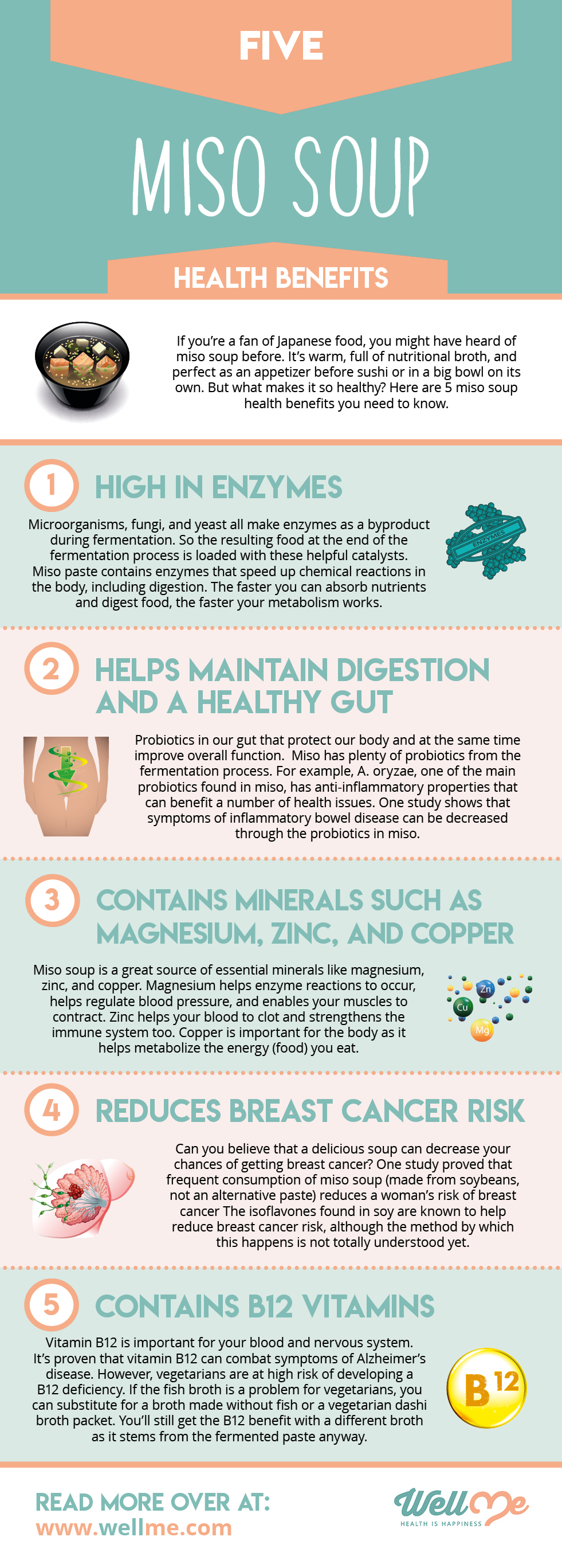
Share this Image On Your Site
References
- [1] https://link.springer.com/chapter/10.1007/978-1-4613-0309-1_12
- [2] https://onlinelibrary.wiley.com/doi/abs/10.1002/elsc.201100179
- [3] https://www.pnas.org/content/107/1/454.short
- [4] http://www.newmicrobiologica.org/PUB/allegati_pdf/2013/3/229.pdf
- [5] https://www.livestrong.com/article/304348-how-many-calories-are-in-miso-soup/
- [6] https://www.jstor.org/stable/24102923?seq=1#page_scan_tab_contents
- [7] https://www.gastrojournal.org/article/S0016-5085(16)33413-8/abstract
- [8] https://www.gastrojournal.org/article/S0016-5085(16)33413-8/abstract
- [9] https://www.sciencedirect.com/science/article/pii/S2213453015000300
- [10] https://www.health.harvard.edu/staying-healthy/precious-metals-and-other-important-minerals-for-health
- [11] https://www.health.harvard.edu/staying-healthy/precious-metals-and-other-important-minerals-for-health
- [12] https://www.health.harvard.edu/staying-healthy/precious-metals-and-other-important-minerals-for-health
- [13] https://www.health.harvard.edu/staying-healthy/precious-metals-and-other-important-minerals-for-health
- [14] https://www.health.harvard.edu/staying-healthy/precious-metals-and-other-important-minerals-for-health
- [15] https://www.health.harvard.edu/staying-healthy/precious-metals-and-other-important-minerals-for-health
- [16] https://academic.oup.com/jnci/article/95/12/906/2520284
- [17] https://www.ncbi.nlm.nih.gov/pmc/articles/PMC5590054/
- [18] https://www.ncbi.nlm.nih.gov/pmc/articles/PMC3695331/
- [19] https://www.cochranelibrary.com/cdsr/doi/10.1002/14651858.CD004394/abstract
- [20] https://www.sciencedirect.com/science/article/pii/S0009898102003078?via%3Dihub
- [21] http://www.onegreenplanet.org/vegan-food/facts-about-miso-with-tips-health-benefits-and-recipes/

